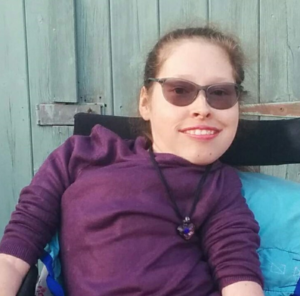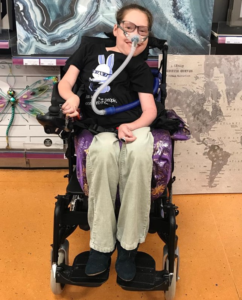Fleur – Everybody: Check Your Sats (Oxygen Saturation)
Fleur – Everybody: Check Your Sats (Oxygen Saturation)
Yes, now. Yes, I know you feel fine. Just go check them, OK. Pretty please?
No sats monitor? No worries. You can ask your community nurse or respiratory consultant for one or buy one online for about £15.
 If you want to know why I’m asking you to check your sats, please read the below. I’ve tried to make it accurate, but if I’m honest, there are some bits where I just don’t remember what order events happened in.
If you want to know why I’m asking you to check your sats, please read the below. I’ve tried to make it accurate, but if I’m honest, there are some bits where I just don’t remember what order events happened in.
For the past few years, my energy levels had been winding down, and I kept losing weight. I assumed this was anything from edging closer to 30, progressive muscle loss, overwork, not enough sleep, not eating enough, not eating the right things or long-term effects of chest infections, which were getting more frequent. I checked the bipap wasn’t broken – it was fine. I spoke with a dietician – who didn’t have the equipment to weigh me and wasn’t able to tell me what a healthy weight would be. I cut down on my voluntary roles. I made more time to rest. This sort of worked, until it didn’t.
Roll back to January, and I was a mess. I was exhausted. I was shaking. I was nervous, irritable. I was gassy. I was dizzy. I was nauseous. I was beginning to experience swallowing difficulties with foods that had always been fine. Migraines – which aren’t unusual for me – were longer, and stronger, lasting up to 11 days and leaving me with no option but to avoid light, sounds, and complex tasks. This started to take a toll on my uni work; I just couldn’t focus for long enough, even on a good day. I ached everywhere.
February: Again, I cut down my obligations to the bare essentials. I discovered I had eczema, not just a small itchy patch, but flaking skin over my entire body, scalp to sole. Small, incredibly itchy, round silver scales started to form on my eyelids. I moisturised, a lot. I still ached everywhere. Small pressure areas became harder to manage, with some areas just refusing to heal. Mouth ulcers were not helping my appetite. My GP gave me a blood test which showed my iron and B12 levels were fine, along with some other tests. I was given some anti-sickness medication (side effects may include nausea ???). I learned to control the nausea with continuous grazing instead.
March: I was falling asleep on the sofa every afternoon. I quit uni, as I just couldn’t keep up with the workload. I asked my GP for migraine medication. Many of them are things that I can’t have, so she prescribed one that acts as an anti-epileptic and a sedative, with common side effects including anaemia, cognitive impairment, muscle weakness, pain, seizures, speech impairment, and a good 30 others listed. I decided I wasn’t that desperate yet and it began to gather dust in the back of the cupboard. I learned to alternate between resting and doing stuff. My weight continued to drop, despite making the best pie ever. I continued to ache everywhere.
I realised the aching was the sign of a growth spurt. Suddenly I was struggling to buy trousers with a 33 inch inside leg and my shoes didn’t fit! Turns out most shops don’t cater to giraffes like me. So it was, as I’d suspected, a hormonal issue! Huzzah! Except the usual course of treatment is a contraceptive which I couldn’t have, either due to using a wheelchair or a family history of heart disease. My options were a) deal with it, or b) have my ovaries surgically removed. Nah, not that desperate either.
A very sensible friend of mine said I might need to use my bipap during the day, or that the settings could be too low. I was certain it was fine. In December, on the suggestion of another very sensible friend, I’d tried using it during the day and ended up with air in my stomach, which I had taken to mean my body didn’t want it and couldn’t deal with it. I wasn’t getting headaches or vomiting in the morning, which had always been what I had been told to watch for to tell me if the overnight settings were too low. My very sensible and caring friends were clearly wrong. But you can’t just say to someone “Nope, you’re wrong”, especially not when you know them to be knowledgeable in all thing’s lungs. So, to prove that I was fine, I got the sats monitor out that evening. SpO2: 93. Heart rate: 110. Sh*t. I knew I’d felt worse earlier that day and had no doubt I’d been below 90 oxygen saturation. And that similar had been going on for 3 months.
Making your heart and lungs do more work than they can manage is dangerous. If this had carried on, there could have been more serious consequences than falling asleep on the sofa and feeling dodgy.
The next day, it took it, very, very easy. The day after that, I got into bed in the middle of the day, put my bipap on, and fell asleep. I woke up feeling a huge improvement. There was no doubt: I needed to use it more.
Over the next few weeks, with the respiratory consultant’s approval, we turned it up. A lot. Gradually, I got more energy, and more sleep, and less nausea, and quite quickly gained weight. One of my PAs, who shall remain nameless, asked if I was pregnant: sudden weight gain and nausea. After I’d stopped laughing, I explained that eating more and my body doing less work had just made me chubby. I stopped putting sugar in my tea and started to get more active and found a middle weight that feels comfortable.
A few months later, my neurologist referred me to a respiratory team who have a lot of experience with MD and SMA. An Arterial Blood Gas analysis revealed I’d turned it up too far, so we turned it down a little. This is when a tiny amount of blood is taken from the front of your ear lobe, except that neither of mine would bleed for the very friendly nurses and so it was taken from the wrist. I’m a bit of a baby with needles, but I could barely feel a thing when they tried the ears. The wrist stung a bit but was worth it to know where the bipap should be set to. And you get tea and biscuits.
They also looked at my old Nippy 3, wrote down the settings, and handed me 2 Nippy 3+ units. These are whisper silent, which I found irritating after 13 years of white noise every night. More importantly, they have a battery inside, meaning I was no longer tied to a plug. It took some getting used to, but after a couple of goes in the garden, I forgot that it was new.
Over the weekend, I took it out of the house. My word, people get out of the way quicker. That’s fine. I had so much more energy to do what I needed to do. That’s great! I’d never realised how much one hour’s pootling of an afternoon wore me out. Not anymore!

I’m now doing OK. After months and possibly years of being under-ventilated, I’m guessing it’s going to take time to completely recover as much as I can. All of the weird symptoms listed above are gone or ebbing away. I’m campaigning again for the rights of disabled people. I’ve re-enrolled for uni. I’m making plans and keeping them. I’m enjoying being back in business. I’m still getting it wrong occasionally and doing too much too quickly. But then, I know what to do to fix it; no worries.
If you start to get any of the symptoms I did, even just grumbling about feeling too old to do what you used to a year ago, please check your sats. Muscles gradually weaken; this means that our respiratory needs will change very slowly over time. Monitoring that change could prevent all of the above happening to you; the occasional sleep study, blood test, and sats check is surely a small price to pay.
Thanks for reading! Fleur 🙂
A resource I found helpful was Breathe with MD.
Please double check all the advice found here with your respiratory consultant before making decisions about your health.
